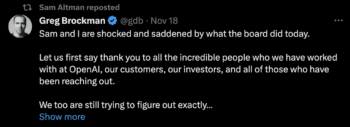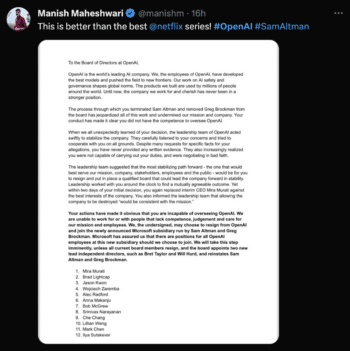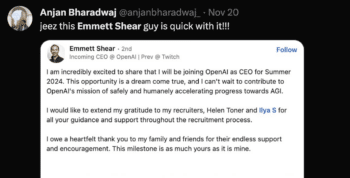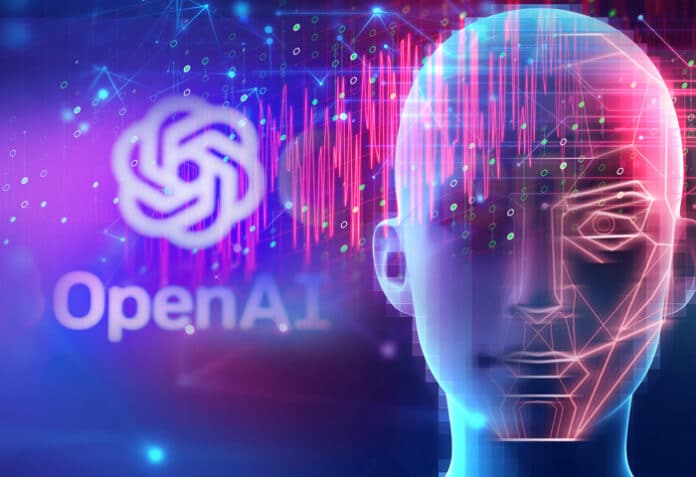When Sam Altman was asked to leave OpenAI, it signaled much more than a CEO’s departure. This move unraveled a narrative that felt straight out of a Silicon Valley playbook, teeming with plot twists, loyalties, and a strategic leap to Microsoft, a tech behemoth. Basically, the drama was so dynamic that it was impossible to predict what’s going to happen next. Altman’s journey from being a pivotal force at OpenAI, a company he co-founded and steered through groundbreaking AI advancements like ChatGPT, DALL-E 3, and GPT-4, to his sudden exit and subsequent alignment with Microsoft, speaks volumes about the dynamic nature of the AI industry.
OpenAI’s official stance on Altman’s departure cited a lack of candidness in his communications with the board, suggesting underlying tensions or disagreements. His exit was abrupt, especially considering his active role in representing OpenAI at major conferences and his interactions with global leaders to shape AI policy. Altman’s influence in AI went beyond OpenAI, extending into broader discussions on AI’s impact and regulation.
The relationship between OpenAI and Microsoft is a critical backdrop to this story. Microsoft, a major investor in OpenAI with a substantial stake, has been integrating OpenAI’s technologies into its own offerings. This partnership and Altman’s new alignment with Microsoft hint at a deeper strategic relationship that could reshape the AI landscape.
This episode shows how leadership dynamics in high-tech ventures are fluid and complex, as well as how emerging technologies, corporate governance, and strategic partnerships interact. Altman’s transition from OpenAI to Microsoft adds another layer to the evolving story of AI development and its influence in the tech world.
Story so far Breaking Down The Acts
Before we delve into the acts of this unfolding drama, it’s essential to set the stage. I have been following Sam Altman’s exit from OpenAI and to be very frank the curiosity is similar when you are reading a thriller and you forget everything else that is happening around you. This event didn’t just signify a change in leadership; it triggered a series of events that shook the very foundations of the AI community. This story is about more than a high-profile CEO leaving; it’s actually the beginning of a new chapter in the future of AI and corporate dynamics.
Now, let’s unfold the acts of this gripping narrative

Act 1:Altman’s Unexpected Exit
Sam Altman’s ouster as OpenAI’s CEO, was a shock to many. The board cited a lack of transparency in his dealings as the reason. Yet, Altman’s legacy at OpenAI was significant. He co-founded the company with notable figures like Peter Thiel and Reid Hoffman, and initially co-chaired with Elon Musk. Altman had been instrumental in directing OpenAI’s trajectory, advocating for AI’s potential and addressing its challenges on global stages.

Act 2: The Employee Uprising
The drama deepened when over 700 OpenAI employees, taken aback by Altman’s abrupt dismissal, rallied in his support. The tweet “Open AI is nothing without its people” became trending and over 500 of the employees threatened to leave for Microsoft, challenging the board’s decision and showcasing a deep-seated loyalty to Altman. It was more than just a protest; it was a testament to Altman’s leadership and vision.

Act 3: The New Leadership and Internal Strife
As OpenAI grappled with this leadership vacuum, Emmett Shear stepped in as interim CEO. Shear, coming from a different organizational culture at Twitch, now faced the daunting task of uniting a fractured workforce while steering OpenAI through one of its most turbulent phases. The internal discord and the sudden shift in leadership raised questions about the future direction of the company and its strategic priorities.

Act 4: Microsoft’s Strategic Acquisition
In a strategic turn of events, Microsoft, which had already invested billions into OpenAI, swooped in to bring Altman and other key OpenAI staff on board. This move not only fortified Microsoft’s AI capabilities but also signaled a significant shift in the AI power dynamics. Microsoft’s rapid response to the upheaval at OpenAI highlighted the high stakes involved in the race to lead the AI revolution.
Whispers And Conspiracies: The Unofficial Tales Of Altman’s Exit
Before delving into the theories surrounding Sam Altman’s departure from OpenAI, it’s important to note that the following interpretations are a collation of various speculations and analyses from different sources. These theories should be taken with a pinch of salt as they represent attempts to make sense of a complex situation that might not be fully revealed to the public. The unfolding story of Altman’s exit and the ensuing developments are emblematic of the rapid and often unpredictable nature of the tech world, especially in the realm of cutting-edge AI.
Theory 1: Secret Deals and Board Circumvention
This theory speculates that Altman may have entered into secret negotiations or deals, possibly with significant entities like Microsoft, without the knowledge or approval of OpenAI’s board. Such covert actions could indicate a serious breach of trust and violation of corporate governance norms. The board’s statement about Altman not being consistently candid lends some weight to this theory. It’s suggested that these secret dealings might have been controversial enough to prompt his abrupt dismissal.
Theory 2: Financial Mismanagement
Another theory focuses on financial missteps under Altman’s leadership. OpenAI, despite its technological prowess, faces enormous operational costs. This theory posits that Altman might have led the company into financial strategies that were unsustainable or hid the true extent of financial liabilities from the board. There’s also speculation about Altman pursuing expensive internal projects against the board’s advice or making personal investments that conflicted with the company’s interests. These financial irregularities, if proven true, could have been a significant factor in his firing

Theory 3: Security and Privacy Concerns
The abrupt halt in new signups for ChatGPT and Microsoft’s reported internal suspension of its use suggest potential security issues at OpenAI. If Altman downplayed serious security flaws in OpenAI’s major products, this could have created a considerable trust deficit with the board. However, the promotion of CTO Mira Murati to interim CEO, who would have been involved in overseeing product safety, somewhat counters this theory. It seems unlikely that such significant security concerns would bypass the CTO’s awareness or responsibility.
Theory 4: Divergent Visions on AI
Altman’s keen interest in artificial general intelligence (AGI) and a more business- focused strategy might not have sat well with OpenAI’s board. The theory hints at a deep divide: Altman steering towards commercial and enterprise applications, while the board aimed to keep AI’s development aligned with broader humanitarian goals. This ideological split, if significant, could be the underlying reason for his unexpected departure.
Theory 5: Impact on Fundraising and Company Valuation
Another theory considers Altman’s role in OpenAI’s fundraising efforts and its valuation. Altman was seen as a key figure in negotiating significant investments, notably from Microsoft. His departure could impact OpenAI’s ability to raise capital in the short term and might indicate a strategic shift in the company’s approach to fundraising and valuation. This theory suggests that his exit could be related to differing views on the company’s financial strategy and future growth trajectory.
Navigating The New Ai Landscape | A Take On The Future
The Emergence of a Microsoft-Centric AI Ecosystem
With Sam Altman and Greg Brockman at the helm, Microsoft is poised to create a formidable AI research team, potentially mirroring the structure and ambition of OpenAI. This move, capping intense negotiations following Altman’s exit from OpenAI, underscores Microsoft’s commitment to leading the AI race. By integrating OpenAI’s visionaries and expertise, Microsoft can leverage its vast resources and infrastructure to accelerate AI innovation, potentially surpassing what OpenAI achieved independently.
Strategic Moves for OpenAI’s Continuity
OpenAI’s new leadership under Emmett Shear faces the challenge of rebuilding trust and redefining the organization’s direction. Addressing governance issues, engaging with stakeholders, and potentially restructuring the leadership could be vital steps in stabilizing OpenAI and ensuring its success in the evolving AI landscape. These efforts are crucial for OpenAI to maintain its relevance and continue its mission in AI research and development.
OpenAI’s Future in the Wake of a Talent Exodus
OpenAI faces a critical juncture with the potential departure of key members to Microsoft. Analysts have expressed concerns that without Altman’s leadership, OpenAI may struggle to sustain its rapid progress. The departure of these talents could mean a significant shift in OpenAI’s strategic initiatives and its ability to maintain its cutting-edge position in AI development.
Microsoft’s Strategic Advantage
Microsoft’s swift move to secure Altman, Brockman, and other top talents from OpenAI not only enhances its competitive edge but also prevents other tech giants from acquiring these AI experts. This strategic acquisition bolsters Microsoft’s AI capabilities, aligns with its enterprise strategy, and is likely to positively impact its future in the AI sector.
To conclude, the unfolding events following Altman’s exit from OpenAI mark a significant shift in the AI industry. Microsoft’s potential to build an OpenAI-like organization within its ecosystem, coupled with OpenAI’s need to adapt and evolve, sets the stage for a new era in AI development. The future of AI now hinges on how these entities navigate this transformative phase, balancing innovation, strategic partnerships, and visionary leadership.




